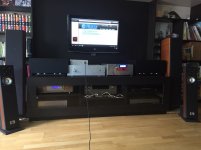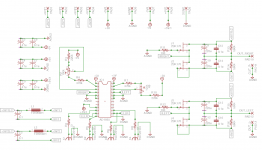Hi Patrick,
I read the full thread in order in my case to implement the SEN with PCM1794.
I already have an idea of what to do based on all the interesting things I read but I was wondering if there was a conclusion on the new implementation you did with Sergio with the floating current source.
Especially there was some listening test to be done and I’d like to get some feedback on those if possible.
I am interested as well on implementation details if they can be revealed, I am going to prototype what I have in mind anyway to start.
Thanks and congratulations again for this nice design.
Alex.
I read the full thread in order in my case to implement the SEN with PCM1794.
I already have an idea of what to do based on all the interesting things I read but I was wondering if there was a conclusion on the new implementation you did with Sergio with the floating current source.
Especially there was some listening test to be done and I’d like to get some feedback on those if possible.
I am interested as well on implementation details if they can be revealed, I am going to prototype what I have in mind anyway to start.
Thanks and congratulations again for this nice design.
Alex.
Thanks. Is there a particular reason for this?
Like performances below expectations or just lack of time to work on it?
Like performances below expectations or just lack of time to work on it?
Hi, I am curious too if somebody had a working I/V converter like SEN or similar...!
I have a PCM1794 too.
I have tryed the passive solution with resistors: 100R sounds terrible, a massive lost of bass and dynamics... with 10R sounds definitiv better but I need to apply a lot of gain at the following OPA to achive the required output voltage (2V). I like the airy soundstage of this passive version, but would be better without compromises...
I have a PCM1794 too.
I have tryed the passive solution with resistors: 100R sounds terrible, a massive lost of bass and dynamics... with 10R sounds definitiv better but I need to apply a lot of gain at the following OPA to achive the required output voltage (2V). I like the airy soundstage of this passive version, but would be better without compromises...
Last edited:
Hi, I am working on one actually for the PCM1794A, based on the SEN architecture.
I am quickly designing a PCB right now, since it is very simple and 2 layers are very cheap nowadays I prefer to go directly for a PCB even for prototyping.
Interesting as I am coming as well from a PCM1794A with a passive I/V but on my side it does sound very good if the R value is low, 100Ohms is definitely too high, and to drive in a low Riv I use DAC paralleling + transformer output in a 2:1 way to gain in amplitude.
Here is my first prototype on another forum => <<OdroDAC>> - 30080995 - sur le forum <<Sources et DAC>> - 1057 - du site Homecinema-fr.com
You can have a look there to avoid being off subject on this thread (sorry for the French).
Still I am interested in trying the SEN to see what it could bring vs. my passive I/V.
With the SEN I plan to use only one DAC chip.
I am quickly designing a PCB right now, since it is very simple and 2 layers are very cheap nowadays I prefer to go directly for a PCB even for prototyping.
Interesting as I am coming as well from a PCM1794A with a passive I/V but on my side it does sound very good if the R value is low, 100Ohms is definitely too high, and to drive in a low Riv I use DAC paralleling + transformer output in a 2:1 way to gain in amplitude.
Here is my first prototype on another forum => <<OdroDAC>> - 30080995 - sur le forum <<Sources et DAC>> - 1057 - du site Homecinema-fr.com
You can have a look there to avoid being off subject on this thread (sorry for the French).
Still I am interested in trying the SEN to see what it could bring vs. my passive I/V.
With the SEN I plan to use only one DAC chip.
9v NiMH vs Li-ION
I understand that batteries are the more practical version for the SEN but after reading batteries as used for floating supply, is there an opinion for using either NiMH vs Li-ION?
NiMH has lower cell voltage with 8.4v vs Li-ION @ 9.6V? Li-ION has higher capacity overall i.e 600mAH vs 300mAH.
Just thinking that Li-ION will offer longer play time...any comments or no issue with whichever one chooses?
I understand that batteries are the more practical version for the SEN but after reading batteries as used for floating supply, is there an opinion for using either NiMH vs Li-ION?
NiMH has lower cell voltage with 8.4v vs Li-ION @ 9.6V? Li-ION has higher capacity overall i.e 600mAH vs 300mAH.
Just thinking that Li-ION will offer longer play time...any comments or no issue with whichever one chooses?

Time for comparison: it was a long journey. I cannot really evaluate anything if I am not able to make an a/b switch.
So I built one NTD1(ESS9018) from OPC, one sen with two AD1865 in balanced configuration and a sen for ESS9018.
Jriver feed them with the same music and I can switch among them with the ugly remotely controlled input selector . I matched the volume.
Long story short, the one you want to listen to is the balanced AD1865. The D1 is darker than the sen. the two sen are very open, but the AD1865 has more body around the instruments. The Dac are fed with Ian i2s to pcm board.
D.
Schematics
Do you happen to have the schematic for the balanced AD1865?
View attachment 640188
Time for comparison: it was a long journey. I cannot really evaluate anything if I am not able to make an a/b switch.
So I built one NTD1(ESS9018) from OPC, one sen with two AD1865 in balanced configuration and a sen for ESS9018.
Jriver feed them with the same music and I can switch among them with the ugly remotely controlled input selector . I matched the volume.
Long story short, the one you want to listen to is the balanced AD1865. The D1 is darker than the sen. the two sen are very open, but the AD1865 has more body around the instruments. The Dac are fed with Ian i2s to pcm board.
D.
Do you happen to have the schematic for the balanced AD1865?
I've built 3 DACs for 9018:
Sen I/V (4 x salas powered, no Tridents) is the more precise one,
Legato ( 4 x salas powered, with Tridents) more relaxed and sweet and more body for mids/bass,
NTD1 (LT1033/1085, with Tridents) analog sounding, micro dynamics, lots of bass
NOTICE: for 9018, the default 680R for I/V is too much, resulting too much gain and probably distortion.
Lower this into 300R, less gain better sound. I think something around 330-350R / 220uf is best combination
Thanks Patric for everything
Sen I/V (4 x salas powered, no Tridents) is the more precise one,
Legato ( 4 x salas powered, with Tridents) more relaxed and sweet and more body for mids/bass,
NTD1 (LT1033/1085, with Tridents) analog sounding, micro dynamics, lots of bass
NOTICE: for 9018, the default 680R for I/V is too much, resulting too much gain and probably distortion.
Lower this into 300R, less gain better sound. I think something around 330-350R / 220uf is best combination
Thanks Patric for everything
Do you happen to have the schematic for the balanced AD1865?
This is the schematic. There is a lot you do not see here:
1) The analog section of the DAC is powered with one super regulator per channel
2) The digital section has its own psu
3) The MSB is implemented like recommended in the datasheet and it has to be tuned like indicated. You need some equipment.
Please note that I made my DAC on a proto board, so there might be mistake in the schematic.
D.
Attachments
I've built 3 DACs for 9018:
Sen I/V (4 x salas powered, no Tridents) is the more precise one,
Legato ( 4 x salas powered, with Tridents) more relaxed and sweet and more body for mids/bass,
NTD1 (LT1033/1085, with Tridents) analog sounding, micro dynamics, lots of bass
NOTICE: for 9018, the default 680R for I/V is too much, resulting too much gain and probably distortion.
Lower this into 300R, less gain better sound. I think something around 330-350R / 220uf is best combination
Thanks Patric for everything
I used 400R in mine, as I had some nice Caddoks of that value. No cap so far, still did not decide. Any suggestion ?
D.
Hello and thank you for the response. I have a es9038 based DAC and was just looking for the I/V converter schematics.
Hello and thank you for the response. I have a es9038 based DAC and was just looking for the I/V converter schematics.
The schematic for ES9018 is different than for AD 1865. You can find it if you search the thread. ES9038 outputs four times the currrent of 9018. So there have to be more or different matched fets, which might prove difficult.
As I already mentioned before, you can use a LU1014 triode cell as in the DAO headphone amp to replace the 2SK369 in the SEN IV.
200mA bias should be sufficient for any DACs that I know of.
And it can also swing a lot of voltage.
🙂
Patrick
200mA bias should be sufficient for any DACs that I know of.
And it can also swing a lot of voltage.
🙂
Patrick
NOTICE: for 9018, the default 680R for I/V is too much, resulting too much gain and probably distortion.
Lower this into 300R, less gain better sound. I think something around 330-350R / 220uf is best combination
What is the gain (dB) result for 680R and 300R.
I'm looking for at least 2 volts of output to
drive amps directly from a ES9018.
I used 400R in mine, as I had some nice Caddoks of that value. No cap so far, still did not decide. Any suggestion ?
D.
I, too, left the caps (LP) out for Sen.
We are on the same boat. I left the decision after building my new amps.
For me it's Sen or NTD1, we are gonna do an A/B test in my friends system, the next week so I'll let you know how it goes.
I have a quad of AD1865 Ks for Sen I haven't started yet, could you describe their sound in contrast with the 9018 one ?
Hello and thank you for the response. I have a es9038 based DAC and was just looking for the I/V converter schematics.
For 9018 the schematics are published here
What is the gain (dB) result for 680R and 300R.
I'm looking for at least 2 volts of output to
drive amps directly from a ES9018.
I haven't measured them, much higher than Legato or any other DAC, with a sense of compression in the highs. I only know the normal listening volume difference in dbs (indicated by the volume pot in the preamp).
- Home
- Source & Line
- Digital Line Level
- Zen -> Cen -> Sen, evolution of a minimalistic IV Converter
